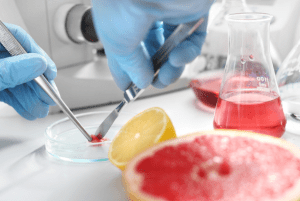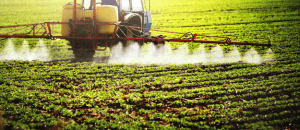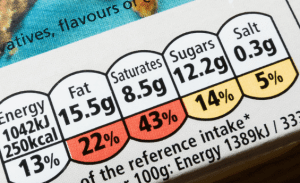How Chromatography is Used in the Food Industry
Using Chromatography for Food Analysis
The food industry bears a crucial responsibility to offer consumers with food products that are high-quality, safe, and highly nutritious. This commitment includes adhering to regulatory standards to safeguard public health. In order to fulfil this obligation, it is imperative to employ analytical techniques to examine food samples for a wide range of parameters, ranging from flavour profiling and the identification and quantification of volatile compounds to assessing food authenticity and more. Among these techniques, both gas and liquid chromatography have emerged as exceptionally powerful tools, offering numerous advantages and applications.1

You might be curious about what factors could render food products unsafe for human consumption. Well, food products consist of a combination of natural compounds and other substances that result from various stages in the food journey, including agricultural treatments, technological processes, and packaging materials.2 For instance, modern agricultural practices and food processing frequently employ chemicals like fertilizers, pesticides, and preservatives. While these chemicals enhance productivity and boost competitiveness and profitability, they can also pose risks to human health if consumed. As a result, food products must undergo rigorous testing to ensure their safety.
What are the technologies for food testing?
As highlighted, Gas chromatography (GC) has emerged as a power analytical tool extensively utilized in the food and beverage industry for food analysis. This powerful technique finds wide-ranging applications in numerous aspects of food analysis, such as determining the composition of food products, discovering their nutritional properties, and addressing various other needs.3
Chemical Analysis of Food
The chemical analysis of food is a vital process that enables us to identify and quantify the various chemicals present in a food product. Once these chemicals have been identified, chromatography plays a crucial role in separating these constituents effectively within the food sample. This separation process is essential for further analysis and understanding of the individual chemical components found in food.3
Pesticide Residue Testing and Microbial Analysis of Food
As highlighted, various agricultural treatments involve the use of agrochemicals to enhance the growth of food products, catering to the needs of the growing human population. These agrochemicals, including pesticides, can leave residues in food products.3 Additionally, animal-derived food products may become contaminated by veterinary drugs that are still present in the animal’s system.3

Furthermore, organic contaminants can enter the food through environmental processes such as air, soil, and water.3 These contaminants and residues are subject to regulation by government agencies, and gas chromatography plays a pivotal role in measuring and ensuring compliance with regulatory requirements. GC techniques such as solid phase microextraction (SPME) or headspace analysis are commonly employed for the extraction and quantification of these residues.1
Nutritional Analysis of Food
Using gas chromatography enables us to gain valuable insights into the nutritional value of the food we consume.4 Manufacturers have the ability to analyse their ingredients by passing them through a chromatography column, providing them with an accurate breakdown of the components they plan to incorporate into their food products.4 This analysis provides crucial information about the levels of vitamins, proteins, preservatives, additives, fats, and more.4

By utilizing GC, manufacturers can determine the specific nutritional values necessary to display on their packaging, as mandated by government health and safety regulations. This empowers consumers to make informed decisions about their diet by being aware of the composition of the food they are consuming, contributing to their ability to maintain a healthy lifestyle.
Quality Control
Quality control is a crucial application of gas chromatography within the food industry. GC plays a vital role in analyzing volatile compounds that contribute to the aroma and flavour of food, thereby facilitating the assessment of food quality, authenticity, and sensory characteristics.1 Moreover, it can identify and quantify volatile compounds that offer valuable insights for flavour profiling and development. To perform flavour analysis and quality control of food, GC techniques such as solid phase microextraction and headspace analysis are commonly employed.1 These techniques enable precise analysis of volatile compounds, ensuring that food products meet the desired standards of taste and quality.
Food Analysis Using Liquid Chromatography
Liquid chromatography also plays a significant role in food analysis, particularly in the field of residue analysis. High-performance liquid chromatography (HPLC) is invaluable for identifying and quantifying specific target analytes, enabling the monitoring of pesticide levels in food products to ensure compliance with government regulations and protect consumers.5 As mentioned earlier, the presence of antibiotics in food as residues from animal treatment poses a risk to human health. This area of food analysis is yet another critical domain where the use of HPLC is indispensable. By employing HPLC, it becomes possible to effectively detect and measure antibiotic residues, enabling the implementation of appropriate measures to safeguard food safety and public health.
Equipment from SCION Instruments
As previously emphasized, chromatography plays a crucial and multifaceted role in the food industry, offering invaluable applications for various food processing needs.
We take great pride in providing top-of-the-line chromatography equipment to support the food and beverage industry.
Discover our comprehensive range of equipment specifically designed for use in the food industry, catering to your unique requirements and ensuring the highest standards of performance and reliability.
Keep in Touch
We’d love to stay in touch. Join us on our social media channels – LinkedIn, Facebook, Twitter – and/or sign up to our newsletter to keep up with all the latest news.
Related Application Notes
- Analysis of Flavour Compounds in Milk Flavourings
- Simultaneous Analysis of Synthetic Food Dyes by HPLC-DAD
- Evaluating Food Products for Furan and Other Volatile Organic Compounds
- Achieving Low-Level Detection of Benzene in Beverages with an Automated Headspace Vial Sampler
- Flavour and Aroma Profile of Hops Using FET-Headspace on the SCION Instruments Vera using GC-MS
- Headspace Analysis of VOCs in Contact Packaging Materials Using the HT3 Automated Headspace Analyser
References
- https://www.drawellanalytical.com/8-key-gas-chromatography-applications-in-food-industry/ *
- https://www.ncbi.nlm.nih.gov/pmc/articles/PMC7555050/pdf/foods-09-01277.pdf
- https://web.vscht.cz/~hajslovj/publications/lehotay_gctrends_trac_vol21_p686-697.pdf
- https://www.chromatographytoday.com/news/gas-chromatography/64/breaking-news/how-is-gas-chromatography-used-for-food-testing/57638
- https://www.chromatographytoday.com/news/hplc-uhplc/31/breaking-news/how-is-hplc-used-in-the-food-industry/56816
